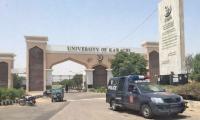KARACHI: The State Bank of Pakistan is widely expected to cut its key interest rate for a second straight meeting next week, as there are signs that inflation is falling.
The majority of analysts anticipate that the central bank will lower its policy rate by 100-150 basis points (bps) on Monday, July 29. The upcoming meeting is drawing attention as the markets will be watching whether the SBP continues its recent trend of monetary easing or maintains the current rate, especially considering the government’s announcement of the budget for the fiscal year 2025 and Pakistan’s recent agreement with the International Monetary Fund for a new 37-month $7 billion loan.
The SBP trimmed its benchmark interest rate by 150 bps to 20.5 per cent last month, following a record-high 22 percent rate that had been maintained for almost a year. This marked the first rate cut by the SBP in four years, in response to an ease in price pressures.
CEO of Topline Securities Muhammad Sohail said, “100 bps cut is likely in line with falling inflation.”Both headline and core inflation have shown marked improvement. For example, average headline inflation has decreased to 23.4 per cent in FY2024 from 29.2 per cent in the previous year. In July, inflation is projected to drop further to around 10.5 per cent, resulting in a real interest rate of 1,000 basis points -- far exceeding the historic 10-year average of -44 basis points.
“We’re expecting a 100bps cut that could lower the policy rate to 19.5 per cent, a level not seen since March 2023,” said an analyst at Arif Habib Limited (AHL) in a note.According to a poll by AHL, 55.7 per cent of respondents expect the SBP to lower the policy rate, while 44.3 per cent anticipate that the policy rate will remain unchanged.
The current account deficit substantially decreased by 79 per cent to $681 million in FY2024, marking the lowest deficit in 13 years. This positive trend has contributed to the stabilization of the rupee, it said.
The SBP’s foreign exchange reserves have also seen a substantial increase. By the end of FY24, reserves had risen to $9.4 billion, up from $4.4 billion a year earlier. This boost in reserves not only enhances the country’s financial stability but also provides additional flexibility for monetary policy adjustments, it added.
The industrial output or large-scale manufacturing industries reported a 7.3 per cent increase in production for May, the highest growth rate in 23 months.
The IMF’s staff-level agreement also emphasizes a commitment to supporting disinflation, which aims to protect real incomes, particularly for the most vulnerable segments of the population. This focus aligns with our expectation of the continuation of the easing policy. Such a reduction would be consistent with the IMF’s policy stance and would further support the ongoing efforts to stabilize the economy and foster growth, it noted.
Besides local economists and analysts, global rating agencies also think disinflation will persist, prompting more rate cuts by the SBP.“We expect that policymakers will cut their key rate at their next meeting. At their last meeting, policymakers said ‘real interest rate still remains significantly positive’, which is important to continue guiding inflation to the medium-term target of 5-7 per cent,” said BMI, a Fitch Solutions Company in its recent report on Pakistan.
“However, an extremely high real interest rate can dampen investments and thereby suppress the already moderated economic growth, thus we believe that policymakers will adjust policy rate in step with inflation,” it added. “We expect that policymakers at the SBP will continue to loosen policy over the longer term, 14 per cent by end of 2025. As inflation eases, we think that policymakers will gradually cut their key policy rate to bring down real rates, which we think will rise sharply in 2024.” “Risks are weighted towards faster-than-expected inflation, which would cause policymakers to slow their easing cycle,” it said.
“The upcoming release of FY25 budgetary measures and adjustments in energy tariffs can cause a sharp increase in short-term inflation and deter policymakers from cutting rates,” it noted.
Despite generally soft economic data, some analysts are cautious about the future trajectory of rate cuts.“We expect the SBP to adopt a wait-and-see approach given higher inflation reading, deterioration in trade balance and current account balance, and better LSM reading post-MPC. The SBP will also assess inflationary pressures emerging from budgetary measures and supply disruption due to ongoing heat wave,” said Awais Ashraf, the director research at AKD Securities Limited.
Chief Minister Murad Ali Shah is seen visiting a stall after inaugurating the Sindh Livestock Expo 2025 on January 17,...
High Commissioner of Rwanda Harerimana Fatou. — APP/FileKARACHI: High Commissioner of Rwanda Harerimana Fatou has...
People buying jewellery at a jewellery shop. — AFP/FileKARACHI: Gold prices decreased by Rs200 per tola on Saturday...
Visitors visiting a place in Japan. — AFP/FileTOKYO: After travelling to Tokyo for meetings, Yoshiki Kojima’s IT...
People shop at a market in Karachi. — AFP/FileLAHORE: Pakistan’s current economic crisis is multifaceted, driven...
Britain’s Prime Minister Keir Starmer waits for the arrival of France’s President Emmanuel Macron at the Chequers,...







